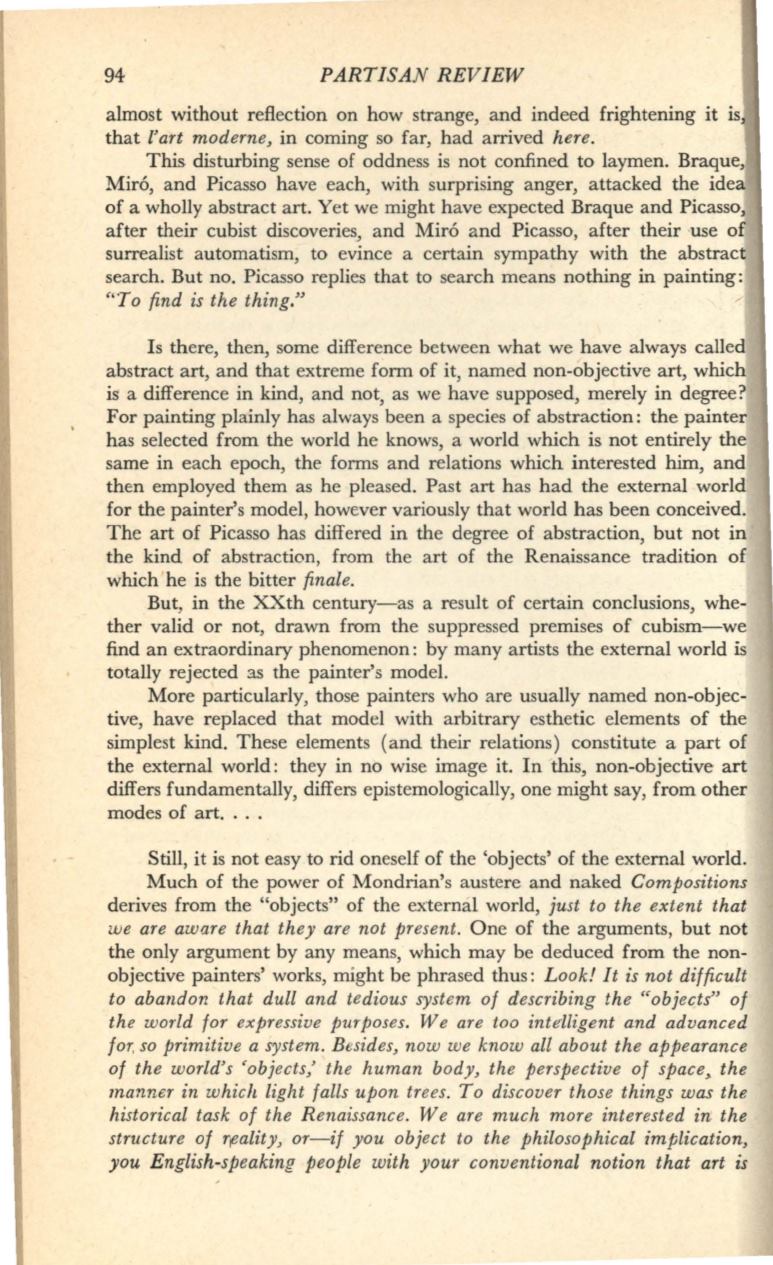
94
PARTISAN REVIEW
almost without reflection on how strange, and indeed frightening it is,
that
l'art moderne,
in coming so far, had arrived
here.
This disturbing sense of oddness is not confined to laymen. Braque,
Mir6, and Picasso have each, with surprising anger, attacked the idea
of a wholly abstract art. Yet we might have expected Braque and Picasso,
after their cubist discoveries, and Mir6 and Picasso, after their ·use of
surrealist automatism, to evince a certain sympathy with the abstract
search. But no. Picasso replies that to search means nothing in painting:
"To find is the thing."
Is there, then, some difference between what we have always called
abstract art, and that extreme form of it, named non-objective art, which
is a difference in kind, and not, as we have supposed, merely in degree?
For painting plainly has always been a species of abstraction: the painter
has selected from the world he knows, a world which is not entirely the
same in each epoch, the forms and relations which interested him, and
then employed them as he pleased. Past art has had the external world
for the painter's model, however variously that world has been conceived.
The art of Picasso has differed in the degree of abstraction, but not in
the kind of abstraction, from the art of the Renaissance tradition of
which he is the bitter
finale.
But, in the XXth century-as a result of certain conclusions, whe–
ther valid or not, drawn from the suppressed premises of cubism-we
find an extraordinary phenomenon: by many artists the external world
is
totally rejected as the painter's model.
More particularly, those painters who are usually named non-objec–
tive, have replaced that model with arbitrary esthetic elements of the
simplest kind. These elements (and their relations) constitute a part of
the external world: they in no wise image it. In this, non-objective art
differs fundamentally, differs epistemologically, one might say, from other
modes of art. . . .
Still, it is not easy to rid oneself of the 'objects' of the external world.
Much of the power of Mondrian's austere and naked
Compositions
derives from the "objects" of the external world,
just to the extent that
we are aware that they are not present.
One of the arguments, but not
the only argument by any means, which may be deduced from the non–
objective painters' works, might be phrased thus:
Look! It is not difficult
to abandon that dull and tedious system of describing the "objects" of
the world for expressive purposes. We are too intelligent and advanced
for,so primitive a system. Besides, now we know all about the appearance
of the world's <objects,' the human body, the perspective of space, the
manner in which light falls upon trees. To discover those things was the
historical task of the R enaissance. We are much more interested in the
structure of Tf3ality, or-if you object to the philosophical implication,
you English-speaking people with your conventional notion that art is


